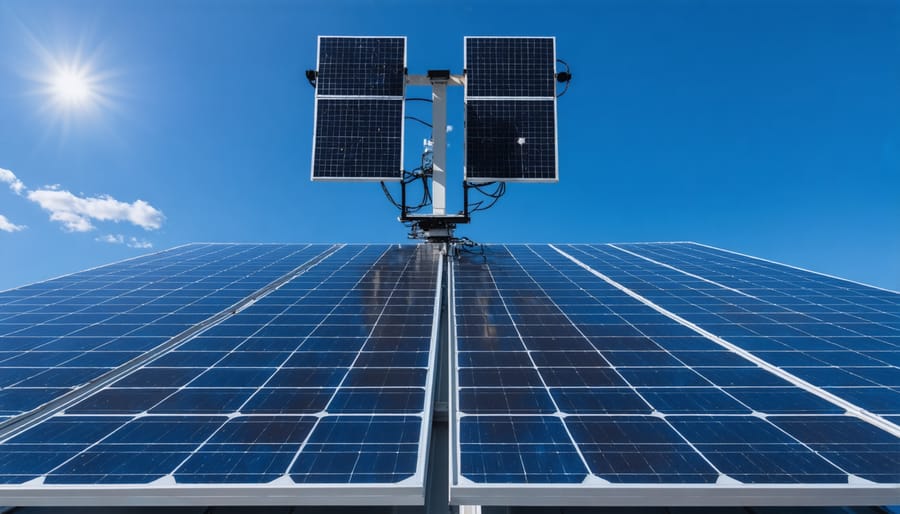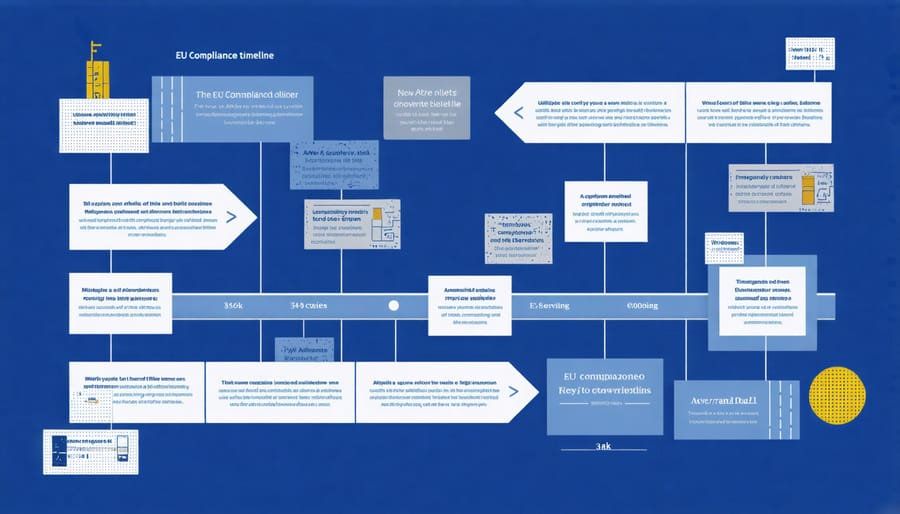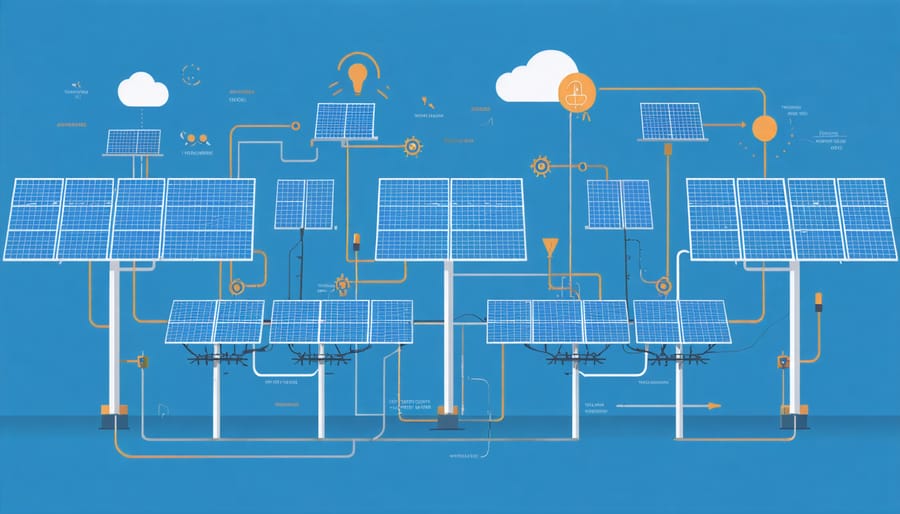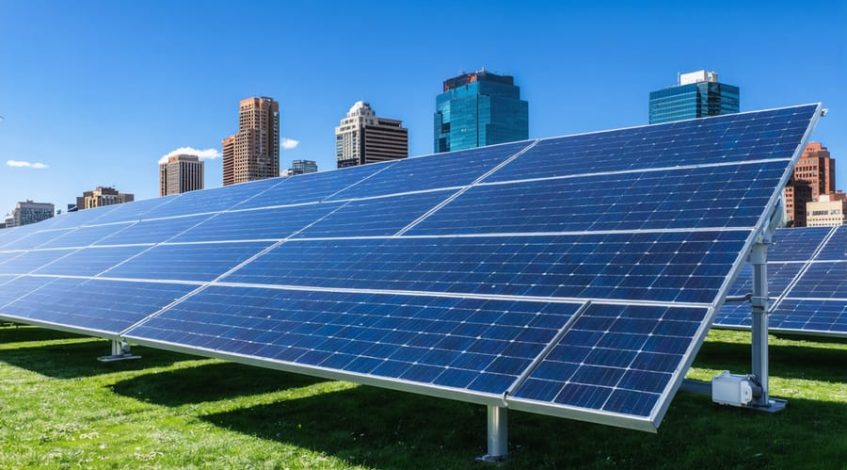Dynamic solar panels are revolutionizing the energy landscape by combining advanced tracking systems with intelligent grid integration capabilities. These sophisticated installations automatically adjust their position throughout the day, capturing up to 40% more energy than traditional fixed panels while responding in real-time to grid demands and weather conditions. For facility managers and business owners, dynamic solar technology represents a significant leap forward in renewable energy efficiency, offering enhanced ROI through smart load management and adaptive positioning systems.
Beyond mere sun-tracking, modern dynamic solar systems incorporate artificial intelligence and predictive analytics to optimize energy production, storage, and distribution. These systems can automatically tilt, rotate, and adjust their configuration based on environmental factors, grid requirements, and energy pricing signals. This flexibility makes them particularly valuable for commercial installations where maximum energy yield and grid compliance are essential.
The integration of dynamic solar panels into existing power infrastructure has become increasingly streamlined, with new regulations supporting their deployment across various commercial and industrial applications. For decision-makers evaluating sustainable energy solutions, these systems offer a compelling combination of increased energy capture, reduced operational costs, and enhanced grid stability benefits.
What Makes Solar Panels ‘Dynamic’?
Smart Tracking Systems
Smart tracking systems represent the intelligence behind dynamic solar panels, utilizing advanced sensors and sophisticated algorithms to maximize energy capture throughout the day. These systems continuously monitor environmental conditions, including solar intensity, weather patterns, and panel temperature, to optimize panel positioning in real-time.
Modern tracking systems employ dual-axis technology, enabling panels to move both horizontally and vertically to maintain optimal angles relative to the sun’s position. This precision tracking can increase energy yield by 25-45% compared to fixed installations, significantly improving return on investment.
The control algorithms governing these systems have evolved to incorporate machine learning capabilities, allowing for predictive positioning based on historical performance data and weather forecasts. This smart adaptation helps prevent energy losses during partial cloud cover and optimizes panel movement to reduce mechanical wear.
Industry leaders like SunPower and NEXTracker have demonstrated the effectiveness of these systems in large-scale installations, where intelligent tracking has reduced operational costs while increasing energy production by up to 40%. The integration of IoT sensors further enhances system performance by enabling remote monitoring and automated maintenance scheduling.

Real-Time Power Adjustment
Dynamic solar panels excel in their ability to adjust power output in real-time, responding to both grid demands and local energy requirements. This sophisticated capability allows facilities to optimize their energy production and consumption patterns while supporting decentralized energy grids through intelligent load management.
The system’s adaptive control mechanisms utilize advanced algorithms to monitor grid frequency, voltage levels, and demand patterns. When grid stability is compromised, these panels can instantly modify their power output, either increasing production during peak demand or reducing it when the grid is oversupplied. This responsiveness helps prevent grid congestion and maintains optimal power quality.
For facility managers, this translates into significant operational advantages. The panels’ ability to match power generation with actual consumption patterns reduces energy waste and minimizes grid export during low-demand periods. Real-time power adjustment also enables facilities to participate in demand response programs, creating additional revenue streams through grid services.
Recent implementations at commercial facilities have demonstrated energy cost reductions of up to 25% through strategic power adjustment and peak shaving capabilities.
New EU Grid Management Regulations
Compliance Requirements
Dynamic solar panel installations must adhere to strict regulatory standards and technical requirements to ensure safe, efficient operation and grid compatibility. All installations must comply with the National Electrical Code (NEC) Article 690, which specifically addresses solar photovoltaic systems, including requirements for system components, circuit requirements, and disconnecting means.
Structural requirements mandate that mounting systems must withstand local wind loads and environmental conditions. The International Building Code (IBC) and local building codes specify minimum structural requirements, including wind resistance ratings and roof load calculations. Dynamic systems require additional engineering analysis due to their moving components.
Grid interconnection standards, as outlined by IEEE 1547, must be met for systems connected to the utility grid. This includes requirements for voltage regulation, frequency synchronization, and anti-islanding protection. Dynamic systems must also incorporate advanced monitoring and control systems that meet UL 1741 certification requirements.
Performance testing and documentation requirements include:
– Initial system certification
– Regular performance verification
– Safety inspection protocols
– Maintenance documentation
– Emergency response procedures
Environmental compliance considerations involve:
– Glare analysis for aviation safety
– Wildlife impact assessments
– Stormwater management plans
– Soil stability studies for ground-mounted systems
Local jurisdictions may impose additional requirements, such as setback distances, height restrictions, and visual impact assessments. Facility managers must maintain current documentation of all compliance measures and schedule regular inspections to ensure ongoing adherence to regulatory standards.
Implementation Timeline
The rollout of dynamic solar panel regulations and implementation is structured across several key phases, beginning in 2024. During Q1-Q2 2024, early adopter programs will launch in California, New York, and Texas, establishing pilot projects for commercial installations. These initial programs will serve as testing grounds for regulatory frameworks and technical standards.
By Q3-Q4 2024, the focus shifts to data collection and performance analysis from early implementations, with regulatory bodies finalizing guidelines for widespread adoption. This phase includes the development of certification processes for installers and equipment manufacturers.
2025 marks the beginning of broader implementation, with a three-tier rollout schedule. Tier 1 (Q1-Q2 2025) encompasses large commercial installations above 500kW. Tier 2 (Q3-Q4 2025) extends to medium-sized commercial installations between 100-500kW. Tier 3 (2026) includes smaller commercial and industrial installations under 100kW.
Compliance deadlines are staggered to allow adequate preparation time. Existing installations have until 2027 to upgrade their systems with dynamic capabilities, while new installations from 2025 onward must include dynamic features from the outset.
The timeline includes quarterly review periods for regulatory adjustments based on implementation feedback and technological advances. Full national integration is expected by 2028, with international standards alignment projected for 2030.

Business Benefits and ROI
Cost Savings Analysis
Dynamic solar panels demonstrate significant cost advantages over traditional fixed systems, with efficiency gains of 25-40% depending on installation conditions and geographical location. This enhanced performance translates into accelerated return on investment, particularly when combined with available solar energy tariff benefits.
A comprehensive analysis of installations across various commercial facilities shows that dynamic systems typically generate an additional 2.5-3.5 kWh per day per kW installed compared to fixed panels. For a standard 100kW commercial installation, this equates to approximately $8,000-12,000 in additional annual energy savings.
The maintenance costs of dynamic systems, while initially higher, are offset by their superior energy capture capabilities. The average payback period reduces from 6-7 years for fixed systems to 4-5 years for dynamic installations, factoring in current energy prices and incentive programs.
Real-world implementation data from manufacturing facilities shows that dynamic systems with advanced tracking algorithms can reduce grid dependency by up to 35% during peak hours, resulting in substantial demand charge savings. When combined with smart energy management systems, these installations demonstrate optimal performance in varying weather conditions, maximizing financial returns through intelligent positioning and load management.
Grid Integration Benefits
Dynamic solar panels significantly enhance commercial solar power integration by providing superior grid stability and management capabilities. Their ability to adjust output in real-time helps utilities better balance supply and demand, reducing strain on the electrical infrastructure during peak consumption periods.
These advanced systems contribute to grid reliability through sophisticated voltage regulation and reactive power control. When integrated with smart grid technology, dynamic solar installations can respond to grid signals within milliseconds, helping prevent outages and maintaining power quality. This rapid response capability is particularly valuable for commercial facilities where power interruptions can result in significant operational losses.
The benefits extend beyond individual facilities to the broader utility network. Dynamic solar systems enable more efficient power distribution by optimizing energy flow based on real-time grid conditions. This results in reduced transmission losses and better utilization of existing grid infrastructure. Utility providers report up to 30% improvement in grid stability when dynamic solar installations are strategically deployed across their network.
For businesses, this translates to more reliable power supply, reduced energy costs, and potential revenue opportunities through grid services participation. The system’s ability to provide ancillary services like frequency regulation and voltage support can create additional value streams through utility incentive programs.
Implementation Strategy
Technical Requirements
Dynamic solar panel systems require specific technical infrastructure to ensure optimal performance and reliability. The foundational requirement is a robust tracking mechanism, typically comprising dual-axis motors capable of supporting panels weighing 40-60 pounds per square meter. These motors must maintain precision movement within 0.1 degrees of accuracy for maximum solar exposure.
The control system needs an advanced microprocessor unit that processes data from multiple sensors, including pyranometers for measuring solar radiation, anemometers for wind speed monitoring, and temperature sensors. This system should operate on a 24V DC power supply with battery backup to ensure continuous operation during grid outages.
Network infrastructure requirements include a dedicated ethernet connection or cellular modem with minimum 4G capabilities for real-time monitoring and remote management. The communication protocol must support standard industry interfaces such as Modbus TCP/IP or BACnet for integration with building management systems.
The mounting infrastructure demands reinforced foundations capable of withstanding wind loads up to 90 mph in normal operation and 120 mph in stow position. The support structure should be constructed from corrosion-resistant materials, typically galvanized steel or aluminum, with a minimum service life of 25 years.
Electrical requirements include DC-AC inverters rated for the system capacity, typically ranging from 10kW to 1MW, with a minimum efficiency of 98%. The system must incorporate rapid shutdown capabilities and meet NEC 2020 requirements for safety compliance.

Integration Process
The implementation of dynamic solar panels requires a systematic approach to ensure optimal performance and regulatory compliance. Begin with a comprehensive site assessment, including solar exposure analysis, structural evaluation, and grid connection capabilities. This evaluation should account for both current energy needs and future scalability requirements.
Following assessment, develop a detailed integration plan that incorporates smart grid technologies and monitoring systems. Installation typically proceeds in four phases:
1. Infrastructure Preparation: Upgrade existing electrical systems, install mounting structures, and implement necessary grid connection points.
2. Panel Installation: Mount dynamic solar panels with their tracking mechanisms, ensuring proper spacing and orientation for maximum efficiency.
3. Control System Integration: Connect monitoring equipment, tracking systems, and energy management interfaces to your facility’s central control system.
4. Testing and Commissioning: Conduct thorough system testing, including performance verification, safety checks, and compliance validation.
Post-installation, implement a monitoring and maintenance schedule to ensure optimal system performance. This should include regular calibration of tracking mechanisms, cleaning protocols, and performance analytics review. Train facility personnel on system operation and establish clear procedures for both routine maintenance and emergency responses.
Remember to maintain detailed documentation throughout the process, including permits, warranties, and operational procedures. This documentation is crucial for regulatory compliance and future system optimization.
Dynamic solar panels represent a significant leap forward in renewable energy technology, offering enhanced efficiency and adaptability that traditional static systems cannot match. As demonstrated through numerous successful implementations, these systems consistently deliver 20-30% higher energy yields while providing facility managers with greater control over their energy production and consumption patterns.
The future outlook for dynamic solar technology is particularly promising, with ongoing developments in tracking algorithms, materials science, and integration capabilities. Industry forecasts suggest that by 2030, dynamic solar installations could account for up to 40% of new commercial solar deployments, driven by improving ROI metrics and increasing grid management requirements.
For business owners and facility managers considering solar investments, dynamic systems present a compelling option that balances initial costs with long-term benefits. As regulatory frameworks continue to evolve and grid requirements become more sophisticated, these systems are well-positioned to meet future challenges while delivering substantial energy savings and environmental benefits.
The technology’s ability to adapt to changing environmental conditions and energy demands makes it an increasingly attractive choice for forward-thinking organizations committed to sustainable operations and energy independence.

